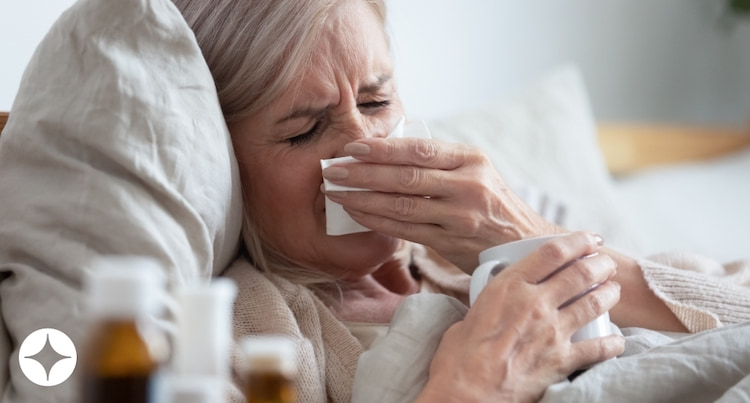SoClean 2 helps maintain your CPAP equipment at the highest level
As colder weather approaches, it's especially important for Canadians to consider their health. Advice includes preparing for temperature-related emergencies[1], following cold weather safety plans[2] and reducing the risk of conditions directly related to cold weather, such as hypothermia[3] and frostbite[4]. It's also vital that individuals take steps to protect themselves from seasonal illnesses[5], such as pneumonia.
Pneumonia and Winter
Studies indicate that cold weather increases respiratory symptoms[6] and the chance of contracting a respiratory illness[7]. Pneumonia, which is a potentially fatal lung condition[8] caused by diverse bacteria, viruses or fungi, cases similarly increase over winter[9]. Indeed, pneumonia and influenza are among the leading causes of death[10] across Canada.
Per statistics from the Canadian Institute for Health Information[11], pneumonia accounted for over 63,300 visits to the emergency department between 2021 and 2022. For the same period, pneumonia was also a significant cause of hospitalization, with around 13,500 Canadians receiving inpatient care for the condition.
Pneumonia and CPAP Therapy
According to a 2014 study[12], approximately 5.4 million adults in Canada have a sleep apnea diagnosis or are at risk of obstructive sleep apnea. However, some professionals believe the actual figure to be much higher[13]. Many people with sleep apnea use CPAP equipment[14] to manage their condition with sleep therapy[15].
Because CPAP machines can be a breeding ground for bacteria, viruses, fungi and other pathogens[16], improper equipment use may cause respiratory infections[17]. Furthermore, some studies directly link sleep apnea with pneumonia[18], with a higher risk for those who use CPAP equipment.
It's important to note that CPAP equipment, in itself, doesn't cause pneumonia. Rather, inadequate cleaning and hygiene practices[19] can allow harmful germs to build up on the machine and its parts. Additionally, standing water in the reservoir can harbor germs. These germs can become trapped in the mask and mouthpiece and pass into the airways through the breathing apparatus.
How CPAP Users Can Reduce the Risk of Pneumonia
As well as standard germ prevention measures[20], CPAP users should take special care to thoroughly clean their sleep therapy devices. Daily hand washing with soap and water helps to remove dangerous pathogens.
The SoClean 2[21] can provide further protection. The easy-to-use device ensures that you maintain your CPAP equipment at the highest possible level, killing up to 99.9% of microorganisms* throughout the mask and hose. The lab-tested cleaning device adds an extra layer of defense to your daily hygiene practices, further reducing the risk of contracting pneumonia or other respiratory illnesses over the winter or any other time of year. Operation time is quick and quiet, and you can a cycle start time to seamlessly fit into your lifestyle. The SoClean 2 is suitable for use with all major CPAP equipment brands, and buyers can be assured by the 2-year warranty.
References
- Canadian Red Cross: Cold-Related Emergencies: Staying Warm and Safe in Canadian Winters
- Government of Canada: Seven steps to cold weather safety
- Canada Safety Council: The Cold Facts on Hypothermia
- WEM: Exploring the Development of a Canadian Frostbite Care Network and the Future of Frostbite Care in Canada Using a Qualitative Approach
- HealthLink BC: Common Illnesses and Injuries During Winter
- National Library of Medicine: Cold weather increases respiratory symptoms and functional disability especially among patients with asthma and allergic rhinitis
- Journal of Allergy and Clinical Immunology: Cold exposure impairs extracellular vesicle swarm–mediated nasal antiviral immunity
- The Lung Association: Pneumonia
- National Library of Medicine: Seasonal Patterns of Invasive Pneumococcal Disease
- Statista: Death rate for influenza and pneumonia in Canada from 2000 to 2021
- Canadian Institute for Health Information
- Canadian Respiratory Journal: Sleep Laboratory Test Referrals in Canada: Sleep Apnea Rapid Response Survey
- Respiratory Therapy Society of Ontario: Obstructive Sleep Apnea: Are Canadians Underdiagnosed and Undertreated?
- National Heart, Lung, and Blood Institute: What is CPAP?
- SoClean Blog Post: Our Top Hacks for Improving Your Sleep Therapy Experience
- National Library of Medicine: Q&A: What are pathogens, and what have they done to and for us?
- Healthline: Can Your CPAP Machine Give You an Upper Respiratory Infection?
- Canadian Medical Association Journal: Sleep apnea and risk of pneumonia: a nationwide population-based study
- Harvard Health Publishing: Can your CPAP make you sick?
- Canadian Centre for Occupational Health and Safety: Good Hygiene Practices - Reducing the Spread of Infections and Viruses
- SoClean 2 CPAP Cleaner and Sanitizer
